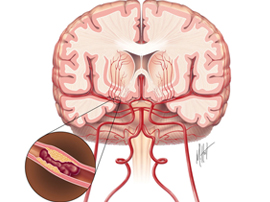Risk Factors for Stroke
Your first line of defense in preventing a stroke 2018 is to know where you stand. So before we get into the actual warning signs for a stroke, let’s review some of the risk factors. Controlling them is not a guarantee against a stroke, of course, but it can lower the chances considerably. Statistics show that up to 50 percent of all strokes are preventable. Everyone has two kinds of risk factors: those they can change and those they cannot.\
Here’s a rundown:
Stroke Risk Factors You Can’t Change
-
Age. The risk of stroke increases with age. Two thirds of strokes happen in people over the age of 65. The chance of having a stroke almost doubles for each decade of life after age 55.
-
Race. Those with higher risk of stroke include African Americans, Native Americans, and Alaskan Natives. African Americans have double the risk of a first ischemic stroke because they have a higher incidence of hypertension and diabetes.
-
Gender. Stroke is about 25 percent more common in men than women until age 75. Overall, however, more women than men die of stroke. Birth control pills and pregnancy pose particular risks for younger women. And because women live longer than men, they are more likely to have an increased death rate after age 75.
-
Family History. Your risk is higher if a parent, grandparent, or sibling has had a stroke. This includes the mini-stroke called a transient ischemic attack (TIA).
-
Personal History. Anyone who has had a prior stroke, TIA, or a heart attack has a much higher risk of another stroke. A TIA is a very strong predictor of a stroke. Those who have had a TIA have about 10 times greater risk for a subsequent stroke — which is why TIAs are also called “warning strokes.”
Stroke Risk Factors You CAN Change
-
Hypertension. High blood pressure is by far the most significant risk factor for stroke. Luckily, this biggest risk factor is one that you can control. It can be managed with lifestyle changes and medication.
-
High Cholesterol. High levels of bad (LDL) cholesterol can result in hardening of the arteries, which leads to plaque deposits on the walls of blood vessels.
-
Stress. Studies show that people who experience high stress levels are more likely to develop hardened arteries than those who stay calm under pressure. The reason for this is that high stress causes the body to release more cortisol (the “fight
or flight” hormone), which causes arteries to narrow. -
Food and Alcohol Choices. Diets high in saturated fats and trans fats raise cholesterol levels, while diets high in salt increase blood pressure. These two factors together can put a great deal of strain on blood vessels and the heart. A moderate amount of alcohol has a protective effect, but alcohol abuse increases risk of stroke.
-
Smoking. The combination of nicotine and carbon monoxide in cigarette smoke (including secondhand smoke) is extremely damaging to the cardiovascular system. Over time, it causes a narrowing and weakening of the arteries called atherosclerosis. This results in a need for the heart to pump harder, leading to hypertension. Smoking combined with the use of oral contraceptives greatly increases the risk of stroke in women.
-
Sedentary Lifestyle and Obesity. Being inactive increases your weight, which leads to an increase in blood pressure.
-
Diabetes. With diabetes comes serious circulation problems that can double the risk of stroke. Also, many people with diabetes have other risk factors, such as being overweight and having high blood pressure and/or high cholesterol.
-
Heart Disease. The same problems that are associated with heart disease (narrowing of the arteries, plaque buildup, etc.) can lead to stroke. That’s why I call stroke a “heart attack in the brain.”
The Five Major Stroke Warning Signs:
If your first line of defense in preventing a stroke is assessing your personal health, your second — and even more important — defense is recognizing the warning signs. This is what will save your life if you’re
headed for a stroke. There are five main warning signs of a stroke. You might experience some or all of them:
- Sudden vision problems; difficulty seeing out of one or both eyes.
- Sudden headache; severe pain with no apparent cause.
- Sudden confusion; you become unable to think or speak clearly, or can’t understand what others are saying to you.
- Sudden numbness; weakness and lack of feeling in the face, arm, or leg, particularly if it is isolated on one side of the body.
- Sudden lack of coordination, including dizziness or loss of balance.
The warning signs of a stroke are very much like the warning signs along a road. They’re there to alert you to a danger you might not see coming. But if you take heed, you can avoid calamity.
Thank you for reading.
To Your Heart Health,

